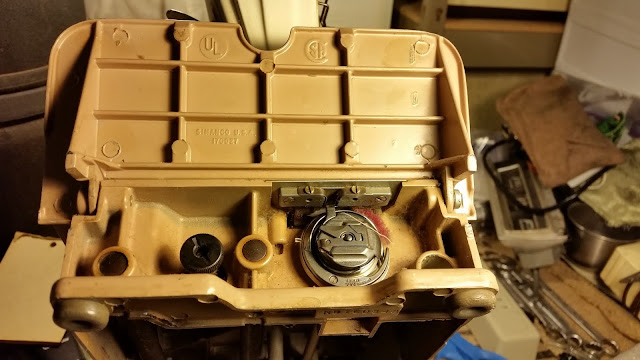As you can see, this sewing machine needs a bit of cleaning. The lady I purchased it from said it was probably good for parts (!). I was thinking that it seemed to be in pretty nice condition to just become a parts machine.
Here are a few more photos to show its condition.
A very clean underside of the machine, and all steel gearing for the full rotary hook.
I love the art deco font they used on the numbers for the stitch length plaque. The numbers don't show up too well in the photo (click on it and you'll get a better view). They're just how a machine of this vintage should look.
The machine didn't come with a cord or foot controller, so I had to improvise a bit when testing it out. I had a Singer foot controller for a slightly newer machine that I'd picked up at the local Goodwill in May, and it worked fabulously. I just needed to be a little on the careful side when working with it. I'll need to pick up the right controller at some point. Or maybe find the right 3-pronged plug and wire up this one that I'm using. [edit - Yes, I'm a doofus sometimes. I realized a couple days ago that this machine takes the same controller as my 401...... and I happen to have an extra one.]
The serial number puts the manufacture date of this machine at 1957, a very good year if I must say so myself.
One downside to a 301 is that it uses a non-standard bobbin case and bobbin (not Class 15 or 66). I think it's only used on 301's and the model 221 Featherweight. Fortunately mine came with a bobbin case and bobbin. So many times old discarded sewing machines are missing their bobbin cases.
This sewing machine had been used a bit, as seen by the ball of lint by the bobbin case. It's always nice to see that someone had gotten some use from an old well-made sewing machine.
After throwing a little oil on pivot points and such, I tried it out. And you know what? It worked just like any old Singer is supposed to. The white stitching is from this machine. It's a little difficult to see, but it sewed through 3 or more layers of denim with no problem whatsoever.
My guess is Nelson's is probably where this sewing machine was first purchased, as the phone number has the earlier-used exchange name "MAin 4-4026".
And the internet being what it is, I was able to dig up this ad in a West Seattle newspaper from December 13, 1962. I wasn't able to find out how long after 1962 Nelson's was in business. Who knows, maybe they are still going strong somewhere.
My 301A sewing machine didn't stray too far from the store it was originally sold from. I'm maybe 10 miles as the crow flies from downtown Seattle.











8 comments:
Nice Machine. The sticker with the old-style phone number is priceless.
Didn't realize these machines took a special bobbin. You can get a foot control at sewclassic.com.
I found this exact LBOW model in Woodinville, WA (and carry case/pedal/attachments) about a year ago and an all-black version (in the Art Deco desk #42) in Edmonds, WA. Have you read about how this machine is designed? I found it to be pretty interesting.
Great blog!
I've used GOJO hand cleaner to remove old oil and grease from my machines. It works well on dried adhesive left from masking tape too.
Thanks for the tip, Jonathan. I'll have to give it a try.
nice
Post a Comment